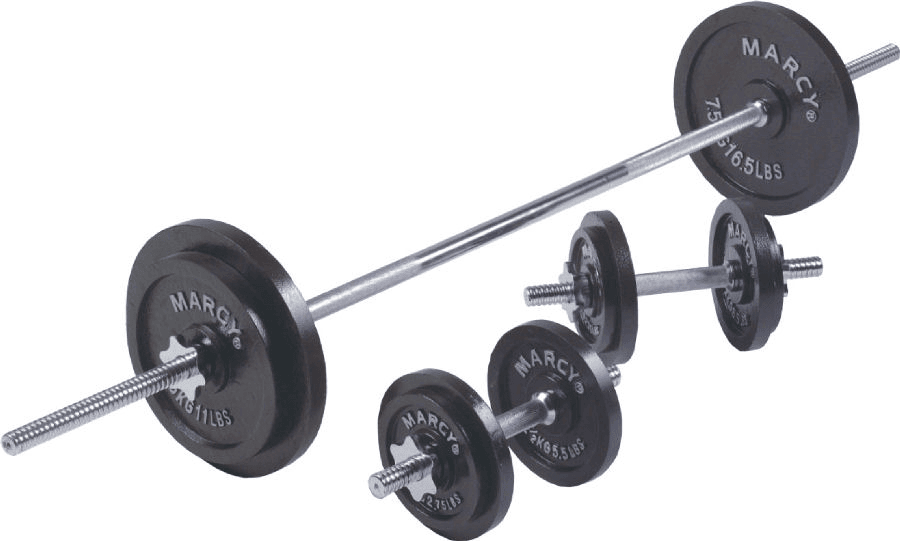Beyond the Basics: A Practical Blueprint for Mastering Barbell and Dumbbell Workouts
Welcome to your all-in-one guide on harnessing the power of two of the most effective strength-training tools—barbells and dumbbells. In this blueprint, we dive into:
- Which tool builds more muscle?
- When to use each for optimal results
- How to use them safely and effectively
- Advanced strategies to craft a hybrid workout
Let’s get started!

Dumbbells vs. Barbells: Which One Builds More Muscle?
The classic debate between Dumbbells vs Barbells is about muscle hypertrophy. Here’s a quick rundown:
- Muscle Activation:
🔥 Barbells: Tend to generate high activation in prime movers (e.g., chest, triceps) thanks to stability and heavy loading.
🤸♂️ Dumbbells: Offer a greater range of motion and force you to engage stabilizer muscles, perfect for correcting imbalances. - Progressive Overload:
➕ Barbells: Allow for small weight increments (2.5–5 lbs) and support heavier loads.
➖ Dumbbells: May have lower weight ceilings but shine in unilateral work. - Range of Motion & Isolation:
🌟 Dumbbells: Enable each arm to move independently, ensuring a full contraction from different angles.
| Aspect | Barbells | Dumbbells |
|---|---|---|
| Muscle Activation | 🔥 High in compound movements (chest, triceps) | 🤸♂️ High in stabilizers; great for isolation |
| Progressive Overload | ➕ Supports heavier weights & small increments | ➖ Limited max weight but ideal for unilateral balance |
| Range of Motion | 🔒 Fixed path may limit full stretch | 🔓 Allows independent movement and full range |
| Safety | ⚠️ Requires a spotter or safety equipment for heavy lifts | 👍 Easier to drop safely, ideal for solo workouts |
Deep Dive into the Tools: Design, Functionality, and Benefits 🔍
- Dumbbells:
- Design: Independent weights with handles, available in fixed or adjustable options.
- Functionality: Excellent for isolation, unilateral training, and a wider range of motion.
- Benefits: Corrects imbalances and offers greater versatility in exercise variations.
- Barbells:
- Design: Long, rigid bar with weight plates at both ends.
- Functionality: Perfect for heavy, multi-joint compound exercises (e.g., squats, deadlifts, bench press).
- Benefits: Maximizes mechanical tension and facilitates gradual strength gains.
Can Dumbbells Build As Much Muscle as Barbells?
The short answer is yes—dumbbells can build as much muscle as barbells when used correctly. Muscle hypertrophy relies on factors such as tension, volume, and progressive overload. Dumbbells are fully capable of delivering these stimuli. In fact, the enhanced range of motion and the activation of stabilizer muscles can lead to balanced muscle development, often rivaling the gains from barbell training. Studies have shown that when training volume and intensity are matched, both tools yield similar muscle growth.
🏆 Final Verdict: Which Should You Use?
| Factor | Best Choice |
|---|---|
| Muscle Activation | Dumbbells |
| Strength Progression | Barbells |
| Safety & Joint Health | Dumbbells |
| Exercise Variety | Dumbbells |
| Progressive Overload | Barbells |
| Home Gym Convenience | Dumbbells |
The Best Approach? Use Both.
For balanced, comprehensive muscle growth, incorporating both dumbbells and barbells into your training regimen is ideal. If your focus is on safety, versatility, and addressing imbalances, dumbbells are a fantastic option. Conversely, if your goal is to lift maximal loads and progress steadily in strength, barbells are indispensable.
💡 Ready to upgrade your home gym?
Discover our top-rated dumbbells for muscle building and take the first step toward achieving your fitness goals!
Situational Applications: Matching Equipment to Training Goals
When to Use Barbells:
- Strength & Mass Building:
Ideal for heavy compound lifts (e.g., barbell squat, bench press, deadlift) to maximize overall strength. - Progressive Overload:
Enables precise weight increases to break through plateaus.
When to Use Dumbbells:
- Isolation & Stability:
Perfect for exercises like dumbbell flyes, curls, or lunges that address muscle imbalances. - Safe Solo Training:
Their design allows for a safer workout when training alone.
Technique Tutorials and Best Practices 📚
Proper Usage Guidelines:
Ensuring the right form is essential for both effectiveness and safety.
Barbell Exercises:
Bench Press:
- Lie flat on a bench with feet firmly on the ground.
- Grip the bar slightly wider than shoulder-width.
- Lower the bar to your mid-chest slowly, then press upward with control.
- Tip: Always use a spotter or safety rack when lifting heavy.
💡 *Do: Keep your elbows at a 45° angle to your body.
❌ Don’t: Bounce the bar off your chest.
Squat:
- Secure the bar on your upper back (use a proper squat rack).
- Keep your chest up and back straight.
- Descend by bending your knees until your thighs are parallel to the floor, then drive upward through your heels.
💡 *Do: Maintain proper alignment throughout.
❌ Don’t: Let your knees collapse inward.
Dumbbell Exercises:
Dumbbell Flyes:
- Lie on a bench with a dumbbell in each hand.
- With a slight bend in your elbows, lower the weights to the sides until you feel a stretch in your chest.
- Bring the dumbbells together above your chest, squeezing your pectorals.
💡 *Do: Keep the movement smooth and controlled.
❌ Don’t: Lower the weights too far.
Single-Arm Row:
- Support your body on a bench with one hand and knee.
- With the other hand, pull the dumbbell towards your hip, keeping your elbow close to your body.
💡 *Do: Focus on a full range of motion.
❌ Don’t: Use momentum to lift.
Crafting Your Hybrid Workout: A Practical Blueprint 📝
Program Design Tips:
A balanced workout routine uses both barbells and dumbbells for maximum results:
- Begin with Barbell Exercises:
- Prioritize heavy compound movements (e.g., barbell squat, bench press, deadlift) to build overall strength and mass.
- Follow with Dumbbell Exercises:
- Transition to isolation and stabilization moves (e.g., dumbbell flyes, lunges, bicep curls) to fine-tune muscle symmetry.
Sample Hybrid Routine Layout:
| Exercise | Equipment | Sets | Reps | Rest |
|---|---|---|---|---|
| Barbell Squat | Barbell | 4 | 6–8 | 90 sec |
| Dumbbell Lunges | Dumbbells | 3 | 10 each | 60 sec |
| Barbell Bench Press | Barbell | 4 | 6–8 | 90 sec |
| Dumbbell Flyes | Dumbbells | 3 | 10–12 | 60 sec |
| Barbell Deadlift | Barbell | 3 | 5–6 | 120 sec |
| Dumbbell Bicep Curls | Dumbbells | 3 | 10–12 | 60 sec |
Advanced Techniques:
- Supersets & Drop Sets: Pair heavy barbell moves with dumbbell isolation exercises to fully exhaust the muscle.
- Periodization: Alternate training phases focused on heavy barbell work for strength and dumbbell work for endurance/definition.
Troubleshooting & Advanced Insights ⚙️
Common Pitfalls:
- Poor Form: Use mirrors or video recordings to check your technique.
- Overtraining: Ensure balanced routines so no muscle group is over-stressed.
- Plateaus: Regularly rotate exercises and adjust rep ranges to keep challenging your muscles.
Advanced Training Strategies:
- Tempo Variations: Slow down the eccentric (lowering) phase to increase time under tension.
- Supersets: Combine a barbell exercise immediately followed by a dumbbell move to boost metabolic stress.
- Self-Assessment Tools: Use apps or training journals to log progress and refine your form.
Safety Reminders:
- Warm-up thoroughly before heavy lifts.
- Use proper safety equipment (spotters, racks).
- Consider occasional sessions with a trainer for professional feedback.
Additional Resources and Next Steps 📚

Work Hard Because Nobody Else Can Do It For You
Building a Solid Foundation for Lifelong Success
Both dumbbells and barbells offer unique benefits for building muscle. Dumbbells excel in providing a greater range of motion, enhanced muscle activation, and versatile, joint-friendly workouts—especially in home gym settings. On the other hand, barbells are unparalleled for heavy lifting and gradual strength progression through smaller weight increments. Ultimately, combining both can create a well-rounded training regimen that maximizes muscle growth and overall strength. Choose based on your goals and space, and train smarter for optimal results!
Thanks For Reading!
